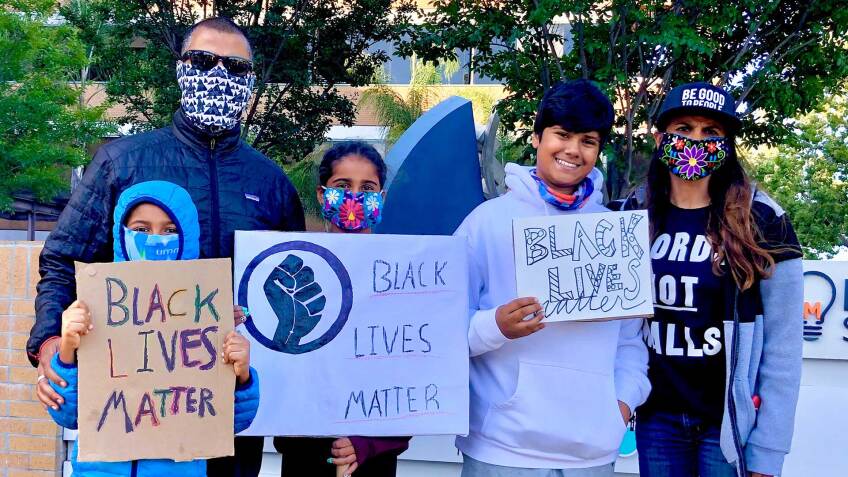Unity in Diversity: Fostering the Pillars of Activism in Children

As we stand amid an era of political, racial and health injustice, many would argue that we as a nation are more divided than ever before, and yet, perhaps this moment brings just enough momentum to unite more deeply — to overcome mere tolerance of our differences and move into true unity and celebration of diversity. If unity is to be achieved, it must be done intentionally and actively. But how do we do it? Where do we start? We start with our children.
Historically, American society has dealt with differences in identity, opinion and behavior in two ways: active intolerance (e.g. aggression, forced assimilation, colonization) and passive tolerance (e.g. co-existence with an “us” and “them” mentality). With active tolerance, those that do not conform are rejected, discriminated against, and/or segregated from the mainstream societal hub of power. With passive tolerance, and without a deeper connection to a greater collective “all,” the competition for power gives way to divisiveness, domination and polarized notions of righteousness.
Perhaps now is the moment to create a third narrative in America, one that exists in other parts of the world – unity and harmony without fragmentation. A unity steeped in a belief that we are all interconnected and that our individual happiness and success are connected to that of our community, and our country. This unity embraces diversity, recognizes differences as enrichment, and breeds curiosity that increases the exchange of ideas and strength of our collective humanity.
Making up nearly 25% of the U.S. population, our children stand ready as an army of change agents, if we as parents, educators and community leaders do our own inner work to model and norm the value of interconnectedness in them at a young age. We need to help this next generation feel connected to each other by way of their communities and inspire them to co-create a world that values inclusion and builds momentum for a positive societal cycle of change. In other words, to catalyze societal transformation, we must turn up the HEAT: Humility-Empathy-Action-Togetherness.
Here are some ideas about fostering each of the pillars of “kindness activism” in our children.
Humility
A modest view of one’s own importance. Humility helps create space to observe our surrounding environments because it removes the focus from ourselves.
- Expose children to people and places that are different from them and their daily environments:
- Go on a hike.
- Experience new landscapes — snow, meadows, forests, oceans.
- Walk around different neighborhoods or visit new neighborhood parks.
- Taste new foods.
- Listen to different types of music.
- Learn about other traditions by listening to people’s stories, attending festivals, reading multicultural books and watching documentaries.
- Help them explore the edge of their discomfort by talking about their experiences of stretching themselves, their patience, or their resources. When children get uncomfortable, they get in touch with their own privilege.
- Model and maintain an attitude of gratitude by creating practices and rituals to reinforce staying in touch with our privilege:
- Journal “things I am grateful for” at regular cadences.
- Start a family gratitude wall or jar for all to add notes/images of things they are thankful for.
- Start a dinner routine where everyone shares gratitude.
- Celebrate “Thankful Thursday” each week and leave a note on a child’s pillow or in a lunchbox highlighting something related to the child (i.e. behavior/actions) that you are thankful for. If you have older children send them a text message!

Empathy
The ability to understand and share the feelings of another. The recognition of our own privilege motivates us to help others. We must model and instill a core value that we are all interconnected; our ability to care for others and our planet, helps us live a safer, healthier and more fulfilled life.
- Debrief “big feelings” so that they can remember what it feels like to be stretched and stressed. Talking about the feelings can sometimes help them to identify those moments in other people.
- Read a book or watch a movie together and discuss the main character’s display (or lack) of “empathy,” or care for others.’
- When young ones make a mistake, help them recognize and address the impact of their actions on others, by asking questions:
- How do you think [insert person’s name] felt when [state the mistake]?
- How would it feel if someone [state the mistake] to you?
- Do you have any ideas to help [insert the person who was impacted by mistake]?

Action
The fact or process of doing something, typically to achieve an aim. Support your child to act upon an interest area or cause. Remember the “humility” aspect of our activism should focus on our ability to partner with people and organizations, not save or co-opt the autonomy of their voice/efforts.
- Actions can range from spreading awareness to raising funds for an organization that supports the change your child wants to make.
- Show appreciation and partnership with community helpers (i.e. local grocers, postal workers, healthcare professionals, first responders, etc.). Establishing a regular practice of brainstorming who to thank and how to thank them is an “act” that changes hearts and minds.
- Facilitate your child’s ability to amplify their voice on particular issues through creative art and other forms of expression. The more we amplify diverse voices, the more we challenge and redefine societal norms that perpetuate a culture of implicit bias. Below are some ideas to consider:
- Start an art gallery wall in your home to showcase your child’s views around community issues.
- Write a story with your child about community activism, kindness, or inclusion.
- Look for local media outlets and submit your child’s poetry, reflections, or other forms of expressions on an issue they care about.
- Host an audience for your child to deepen awareness on a given issue. This can happen virtually through a chat, video meeting or a social media page.
- Create issue jars (i.e. Gender Jar) where family members can catch/capture media messages and biased rhetoric that perpetuate stereotypes or inhibit change. Then periodically empty the jar and talk about the messages as a family.

Togetherness
The state of being close to another person or other people. Being and “doing” together as a family in a consistently safe environment creates security and a sense of belonging. With that foundation, children are more likely to stay humble, and therefore motivated to take action.
- Prioritize regular “protected family time” both in smaller (daily) and longer (weekly/monthly) amounts. This is time just for your family to do something together with intention.
- Have fun, rest and learn together:
- Start a family TV show.
- Play family games and let kids choose activities to lead.
- Plan scavenger hunts for each other.
- Share family reading time where people read their own books in the same room for 20 minutes.
- Celebrate each other’s milestones with playful rituals: Designate special meals to eat when commemorating something special. Is there a celebration food your children enjoy?
- Use streamers and decorations for events.
- Create a culture of surprising each other.
The more that we as parents and caregivers actively promote an ethos of humility and empathy in our children, the more inspired they will be to actively influence their surroundings. Continuing to create an emotionally safe space of togetherness serves to help them stay open to learning and practicing their voice for change. The aim is not perfection, but rather the optimism and resilience to try our best, again and again, and to live our lives with intention.





